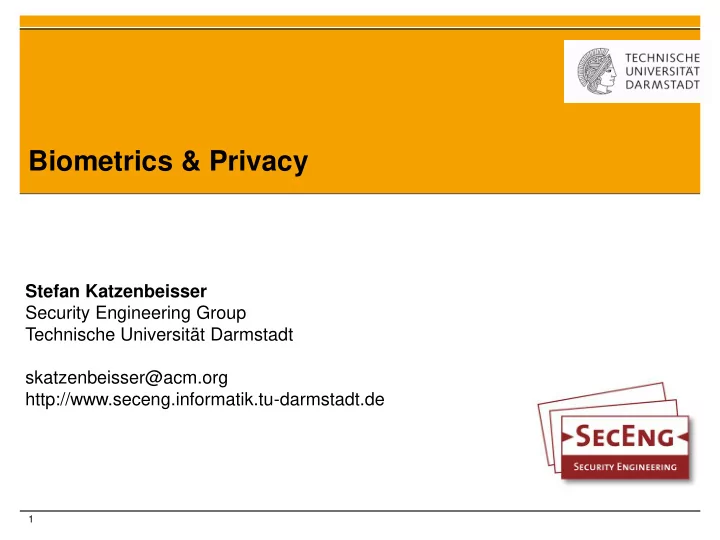

Biometrics & Privacy Stefan Katzenbeisser Security Engineering Group Technische Universität Darmstadt skatzenbeisser@acm.org http://www.seceng.informatik.tu-darmstadt.de 1
Biometrics Goal : Identification of people through “intrinsic” features of a person Advantages: Feature cannot be lost or stolen Easy to use, no password necessary Uniqueness Forgery resistance (?) Disadvantages: Privacy problems Low level of acceptance May be measured without consent of user No revocation mechanism 2
Requirements Universality : Every person has the feature Uniqueness : Feature is unique for a person Permanence : Feature does not change over time Feature can be measured with sensors Performance : Fast and accurate measurements Acceptance of user Security against forgeries 3
Enrollment Registering a user is called enrollment During the process, the biometrics are measured and ... ... a „template“ is stored Subsequent measurements are matched against templates only Can be combined with preprocessing to identify “robust” features Examples: Fingerprints: minutiae extraction Face recognition: computation of eigenfaces DNA: extraction of Short Tandem Repeats 4
Verification Matching a „template“ against a new measurement Must be robust against noise in measurements Essentially a classification problem well-studied in statistics Classification will never be perfect due to inherent statistical variation 5
Parameters of a Biometric System (1) False positives: Unauthorized person will wrongly be identified May yield a security problem False Acceptance Rate (FAR) False negatives: Authorized person will not be identified May yield problems regarding acceptance & usability False Rejection Rate (FRR) Biometrics is based on statistical tests; FAR and FRR cannot simultaneously be made zero! FAR and FRR can be influenced by adding features Equal Error Rate (EER) Mostly „dubious“ numbers based on vendor data 6
Parameters of a Biometric System (2) Error rate FAR FRR EER Number of features 7
Fingerprints (1) Most algorithms based on minutiae : special points of the fingerprint Pattern of minutiae seems to be unique for each person Minutiae represented by position and angle Comparison of minutiae only Problems: Spatial synchronization, missing minutiae due to noise, ... 8
Fingerprints (2) Represent a fingerprint as a sequence of minutiae ((x 1 , y 1 , 1 ), (x 2 , y 2 , 2 )..... , (x n , y n , n )) 2 2 d ( x x ) ( y y ) Measure distance between minutiae i j i j i j , if i j 180 360 - i j , if i j 180 9
Fingerprints (3) Select tolerance levels dTol and Tol Two minutiae match if d dTol and Tol Two fingerprints match, if at least k minutiae match Number k determins accuracy of test 10
Face Recognition (1) Several algorithms known to recognize faces on images One of the most known algorithms relies on “eigenfaces” Face image is represented as vector in high-dimensional space (coordinates of vector correspond to gray-scale values of pixels) Use of Principal Component Analysis (PCA) to determine low-dimensional subspace vector of high-dimensional space should be represented as linear combination of low- dimensional vectors with “small information loss” transforms a large number of correlated values into a smaller number of uncorrelated variables (principal components) 11
Face Recognition (2) Enrollment Given some training images (e.g. images of the enrollment phase), PCA is used to determine principal components (eigenfaces), forming the „face space“ All enrolled images are projected into the face space to obtain a biometric template Face space representation represents „approximation“ of faces 12
Face Recognition (3) Recognition Every face image is thus represented as a small vector in face space Upon recognition, the new face image is projected into the face space to obtain the facial template The facial template is compared to templates stored in the database The face template from the database with minimal Euclidean distance is chosen, or a mismatch is reported if this distance is larger than a threshold Problems to be solved: light conditions, registration of images, quality of photos, ... 13
Privacy? Use of biometrics raises privacy problems! This is particularly true for „intrusive“ biometrics: Patters of veins (medical data!) DNA (may code health-relevant data) Is biometric data a secret? Attacks: Fabricate artificial fingerprint to deceive sensor (liveness test required!) Attacks against person (cut off finger?) Privacy-Enhancing Technologies for biometric data 14
Recommend
More recommend